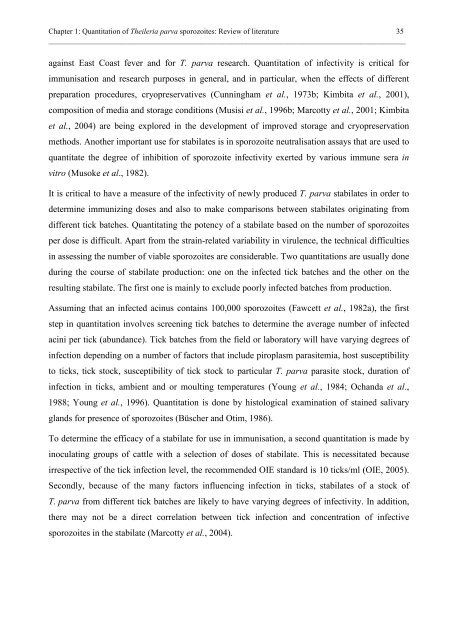In vitro quantitation of Theileria parva sporozoites for use - TropMed ...
In vitro quantitation of Theileria parva sporozoites for use - TropMed ...
In vitro quantitation of Theileria parva sporozoites for use - TropMed ...
You also want an ePaper? Increase the reach of your titles
YUMPU automatically turns print PDFs into web optimized ePapers that Google loves.
Chapter 1: Quantitation <strong>of</strong> <strong>Theileria</strong> <strong>parva</strong> <strong>sporozoites</strong>: Review <strong>of</strong> literature 35<br />
______________________________________________________________________________________________<br />
against East Coast fever and <strong>for</strong> T. <strong>parva</strong> research. Quantitation <strong>of</strong> infectivity is critical <strong>for</strong><br />
immunisation and research purposes in general, and in particular, when the effects <strong>of</strong> different<br />
preparation procedures, cryopreservatives (Cunningham et al., 1973b; Kimbita et al., 2001),<br />
composition <strong>of</strong> media and storage conditions (Musisi et al., 1996b; Marcotty et al., 2001; Kimbita<br />
et al., 2004) are being explored in the development <strong>of</strong> improved storage and cryopreservation<br />
methods. Another important <strong>use</strong> <strong>for</strong> stabilates is in sporozoite neutralisation assays that are <strong>use</strong>d to<br />
quantitate the degree <strong>of</strong> inhibition <strong>of</strong> sporozoite infectivity exerted by various immune sera in<br />
<strong>vitro</strong> (Musoke et al., 1982).<br />
It is critical to have a measure <strong>of</strong> the infectivity <strong>of</strong> newly produced T. <strong>parva</strong> stabilates in order to<br />
determine immunizing doses and also to make comparisons between stabilates originating from<br />
different tick batches. Quantitating the potency <strong>of</strong> a stabilate based on the number <strong>of</strong> <strong>sporozoites</strong><br />
per dose is difficult. Apart from the strain-related variability in virulence, the technical difficulties<br />
in assessing the number <strong>of</strong> viable <strong>sporozoites</strong> are considerable. Two <strong>quantitation</strong>s are usually done<br />
during the course <strong>of</strong> stabilate production: one on the infected tick batches and the other on the<br />
resulting stabilate. The first one is mainly to exclude poorly infected batches from production.<br />
Assuming that an infected acinus contains 100,000 <strong>sporozoites</strong> (Fawcett et al., 1982a), the first<br />
step in <strong>quantitation</strong> involves screening tick batches to determine the average number <strong>of</strong> infected<br />
acini per tick (abundance). Tick batches from the field or laboratory will have varying degrees <strong>of</strong><br />
infection depending on a number <strong>of</strong> factors that include piroplasm parasitemia, host susceptibility<br />
to ticks, tick stock, susceptibility <strong>of</strong> tick stock to particular T. <strong>parva</strong> parasite stock, duration <strong>of</strong><br />
infection in ticks, ambient and or moulting temperatures (Young et al., 1984; Ochanda et al.,<br />
1988; Young et al., 1996). Quantitation is done by histological examination <strong>of</strong> stained salivary<br />
glands <strong>for</strong> presence <strong>of</strong> <strong>sporozoites</strong> (Büscher and Otim, 1986).<br />
To determine the efficacy <strong>of</strong> a stabilate <strong>for</strong> <strong>use</strong> in immunisation, a second <strong>quantitation</strong> is made by<br />
inoculating groups <strong>of</strong> cattle with a selection <strong>of</strong> doses <strong>of</strong> stabilate. This is necessitated beca<strong>use</strong><br />
irrespective <strong>of</strong> the tick infection level, the recommended OIE standard is 10 ticks/ml (OIE, 2005).<br />
Secondly, beca<strong>use</strong> <strong>of</strong> the many factors influencing infection in ticks, stabilates <strong>of</strong> a stock <strong>of</strong><br />
T. <strong>parva</strong> from different tick batches are likely to have varying degrees <strong>of</strong> infectivity. <strong>In</strong> addition,<br />
there may not be a direct correlation between tick infection and concentration <strong>of</strong> infective<br />
<strong>sporozoites</strong> in the stabilate (Marcotty et al., 2004).











